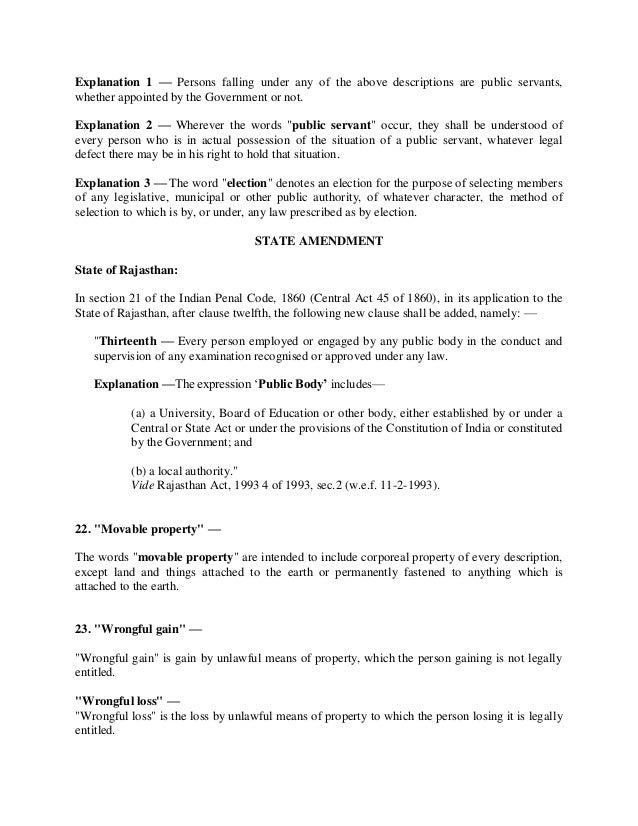Ipc Bare Act
Download pes 2015 setting exe files found Uploaded on TraDownload and all major free file sharing websites like 4shared.com, uploaded.to, mediafire.com and many others. Pes 2015 setup download.
The Indian Penal Code,1860 Citation Territorial extent (except the state of ) Enacted by Date enacted 6 October 1860 Date assented to 6 October 1860 Date commenced 1 January 1862 Committee report Amends see Related legislation Status: Amended The Indian Penal Code ( IPC) is the of India. It is a comprehensive code intended to cover all substantive aspects of. The code was drafted in 1860 on the recommendations of first law commission of India established in 1834 under the under the Chairmanship of. It came into force in during the early period in 1862. However, it did not apply automatically in the, which had their own courts and until the 1940s. The Code has since been amended several times and is now supplemented by other criminal provisions. After the, the Indian Penal Code was inherited by its successor states, the and the, where it continues independently as the.
Section 498A vis-a-vis section 113 of Evidence Act Section 498A of the Indian Penal Code or section 113A of the Indian Evidence Act has not introduced invidious classification qua the treatment of a married woman by her husband or relatives of her husband vis-a-vis the other offenders.
The (RPC) applicable in is also based on this Code. After the separation of from Pakistan, the code. The Code was also adopted by the British colonial authorities in, (modern Sri Lanka), the (now part of Malaysia), and, and remains the basis of the criminal codes in those countries. Contents • • • • • • • • • • • • • • • • History [ ] The draft of the Indian Penal Code was prepared by the First Law Commission, chaired by in 1834 and was submitted to Governor-General of India Council in 1835.
Its basis is the law of England freed from superfluities, technicalities and local peculiarities. Elements were also derived from the and from 's of 1825.
Indian Penal Code Pdf Download
The first final draft of the Indian Penal Code was submitted to the Governor-General of India in Council in 1837, but the draft was again revised. The drafting was completed in 1850 and the Code was presented to the Legislative Council in 1856, but it did not take its place on the statute book of British India until a generation later, following the. The draft then underwent a very careful revision at the hands of, who later became the first Chief Justice of the, and the future of the Calcutta High Court, who were members of the Legislative Council, and was passed into law on 6 October 1860. The Code came into operation on 1 January 1862. Macaulay did not survive to see his masterpiece come into force, having died near the end of 1859 Objective [ ] The objective of this Act is to provide a general for India.
Though not the initial objective, the Act does not repeal the penal laws which were in force at the time of coming into force in India. This was so because the Code does not contain all the offences and it was possible that some offences might have still been left out of the Code, which were not intended to be exempted from penal consequences. Though this Code consolidates the whole of the law on the subject and is exhaustive on the matters in respect of which it declares the law,many more penal statutes governing various offences have been created in addition to the code. Structure [ ] The Indian Penal Code of 1860, sub-divided into 23 chapters, comprises 511 sections. The Code starts with an introduction, provides explanations and exceptions used in it, and covers a wide range of offences.
Universal Law Publishing. • ^ Lal Kalla, Krishan (1985). Jammu and Kashmir: Mittal Publications.
Retrieved 19 September 2014. Retrieved 19 September 2014. • B.M.Gandhi.
Indian Panel Code (2013 ed.). • B.M.Gandhi.
Indian Penal Code. Retrieved 2018-09-24. • Venkatesan, J. Retrieved 2018-09-24. Download the three idiots movie. Times of India. 6 September 2018. Retrieved 7 September 2018.
Retrieved 2018-09-09. The Times of India.
10 December 2014. Retrieved 15 August 2015. Press Information Bureau.
Ipc Bare Action
Ministry of Home Affairs, Government of India. Retrieved 15 August 2015. The Indian Express. Retrieved 15 August 2015. 10 August 2015. Retrieved 15 August 2015.
The Times of india. 17 July 2015. Retrieved 15 August 2015. The Times of India. 3 December 2011. Retrieved 15 August 2015. • Abrams, Corinne (3 September 2015).

Retrieved 2012-05-23. • Parliament of India. Retrieved 7 June 2015. This article incorporates text from this source, which is in the.
Universal Ipc Bare Act
Current Publications. Retrieved 8 June 2015. The New Indian Express. Retrieved 2018-09-24.
Ipc In Hindi Pdf
• Henry Scholberg (1992),, NorthStar Publications, 1992. People were saying, 'Twenty plus Four equals Char Sau Bees.' Char Sou Bees is 420 which is the number of the law that has to do with counterfeiting. • Star Plus,, Popular Prakashan,. Tazeerat-e-hind, dafa 302 ke tahat, mujrim ko maut ki saza sunai jaati hai. • Alok Tomar; Monisha Shah; Jonathan Lynn (2001),, Penguin Books in association with BBC Worldwide, 2001,. we'd have the death penalty back tomorrow.